Exploring the Elegance of the Black Wedding Veil
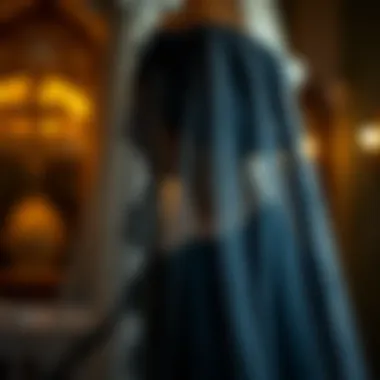
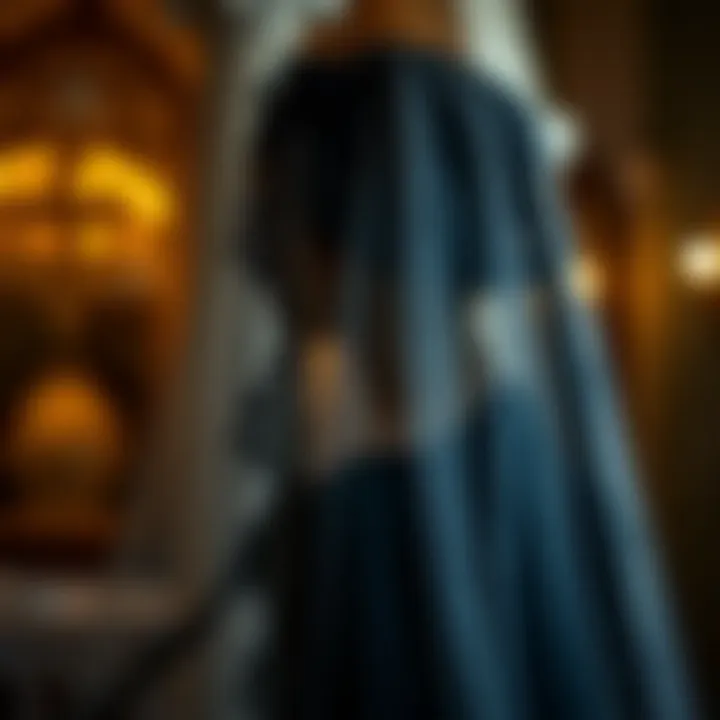
Intro
The black wedding veil, often painted in shadows in the spectrum of bridal fashion, presents a striking alternative to the conventional white, emblematic of purity and innocence. But the allure of the black veil lies much deeper; it intertwines with historical narratives, shifting cultural perceptions, and modern expressions.
This article peels back the layers of this captivating accessory, examining how it has evolved over time and how it's making waves in today's weddings. As designers and brides alike gravitate towards bold statements, the black veil emerges not just as a fashion choice, but as a symbol of individuality, rebellion, and sophistication.
By dissecting its rich heritage, we will uncover the black wedding veil's meaning across various cultures. Moreover, we will reflect on its recent resurgence, propelled by a desire for authenticity in a world saturated with tradition. Tips on styling and integrating this unique element into weddings will also be shared, ensuring that those interested can embrace this trend with confidence and flair.
Ultimately, we hope to provide a comprehensive narrative that allows both designers and brides to appreciate the black wedding veil as a canvas of expression, romanticism, and modernity.
Prologue to the Black Wedding Veil
When one thinks of traditional weddings, an image of a glowing bride adorned in white often comes to mind. This luminous hue, a symbol of purity and innocence, has dominated bridal fashion for centuries. Yet, lurking within the shadows of convention lies an alternative that is gaining traction—the black wedding veil.
The black veil, once dismissed as a harbinger of gloom, has now found its footing as a striking choice for modern brides looking to make a bold statement. It allows individuals to express their uniqueness and defy the norms that have governed wedding attire for generations. Making the switch from white to black is not merely a fashion choice; it's a cultural declaration, a fresh take on what it means to enter matrimony in today’s world.
As we delve into the captivating narrative surrounding the black wedding veil, we will explore its definition and basic overview, as well as the rich symbolism that accompanies the color black. Understanding these facets is crucial for anyone considering adopting this unconventional accessory. Not only does it open doors to a broader understanding of bridal decisions, but it also allows for an enriching discussion on the implications of color in wedding ceremonies.
Definition and Basic Overview
The black wedding veil can be defined as a bridal accessory, typically crafted from sheer fabric that elegantly covers the bride’s face or drapes over her hairstyle. Traditionally, it can also be paired with a black gown or accessories that complement the veil’s dark hue. While the classic wedding veil is often white or ivory, the beauty of the black veil lies in its dramatic appearance and bold allure.
Adopting a black veil signals a shift in traditional values. It embodies an alternative narrative focusing on individuality and a departure from the normative white dress code. In a society where personal expression is celebrated, the black wedding veil stands out as a powerful emblem of self-identity and personal choice.
The Symbolism Behind the Color Black
Black, as a color, is often associated with a spectrum of meanings that can vary across cultures. In many Western societies, it’s considered synonymous with mourning; however, its implications stretch far beyond that somber definition. In the realm of fashion, black is recognized for its sophistication and elegance. It evokes a sense of authority, power, and, importantly, liberation.
Brides choosing a black veil might embrace the deeper meanings intertwined with this color. Black can symbolize strength and resilience—qualities many brides wish to bring into their union. It can also represent a bold rejection of the restraints imposed by societal expectations. In some contexts, black denotes mystery and intrigue, qualities some might wish to radiate as they embark on their new chapter.
"Black, as a shade, represents not just absence but also the presence of myriad possibilities. It stands as a canvas waiting for vibrant contrasts to take life."
Ultimately, the decision to don a black wedding veil is not just about style; it’s an odyssey of individual significance and cultural connotation. As we further unravel the historical context of the black wedding veil, along with its modern resurgence and practical implications, we'll see that this choice is steeped in rich, multifaceted layers deserving of exploration.
Historical Context
Understanding the historical context of the black wedding veil is pivotal, as it not only unveils the evolution of bridal fashion but also highlights the changing perceptions surrounding marriage and symbolism. Throughout the ages, wedding veils have played a crucial role in nuptial ceremonies, encapsulating both societal norms and individual expressions. The black wedding veil, in particular, serves as a fascinating study of how traditions may transform, adapt, and even reintegrate into modern narratives.
Origins of Veils in Wedding Traditions
The concept of a wedding veil predates many modern customs, tracing its roots back to ancient civilizations. In the Roman era, brides wore veils called ‘flammeum’ that were bright red to symbolize a burning passion and to protect the bride from evil spirits. Indeed, veils have historically been employed as a mystical barrier, shielding brides from malevolent forces accumulating around them.
- Ancient Rome: Veils were used to ward off evil spirits.
- Middle Ages: A transition occurs as veils shift in color; white dominates, representing purity.
- Victorian Era: The use of delicate lace became a fashionable accent, introducing opulence into bridal attire.
By examining these early notions, one notices a continuous thread woven through time, culminating in today's multifaceted conversations about bridal attire.
Black Veils Through the Ages
When discussing black wedding veils, one must recognize that black has held diverse connotations in various historical contexts. In the Victorian era, black was often linked to mourning; thus, a black veil may have indicated a widow’s redesignation of her love and commitment after loss. However, in the contexts of royalty and nobility, it assumed a different meaning.
Consider Queen Victoria of the United Kingdom, who popularized the white wedding dress. Ironically, her choice established a long-standing tradition that veils in hues of white or ivory became synonymous with weddings. Despite this dominance of white, black veils popped up throughout history as bold statements of individuality. In more adventurous cultures, some brides donned black to showcase strength, using shade to defy societal norms.
Cultural Variations and Interpretations
As the black veil continues to raise eyebrows and elicit intrigue, its cultural significance cannot be overlooked. Various societies across the globe put their own stamp on this piece of fabric.
- Western Perspectives: In contemporary Western societies, a black wedding veil may represent rebellion against traditional expectations. It signals an embrace of darker themes such as goth culture, or a celebration of a person's unique identity.
- Asian Traditions: In certain Asian cultures, black can signify prosperity and happiness. Hence, a black wedding veil could be embraced as a symbol of good fortune.
- African Cultural Practices: In several African communities, black is a color of mourning but can also reflect strength and resilience in rituals. This duality creates a rich narrative around the use of black fabric in celebrations.
- Latin American Influences: Latin American cultures highlight vibrant festivities; thus, incorporating black in wedding attire can symbolize sophistication while adding flair to traditional celebrations.
In summary, examining the historical context of black wedding veils reveals layers of meaning. This accessory is not merely a piece of clothing but a reflection of the intricate network of history, culture, and personal expression.
"By exploring the rich tapestry of cultural variations and historical evolution, we come to see the black wedding veil as a mirror reflecting our modern sensibilities and deep-rooted traditions."
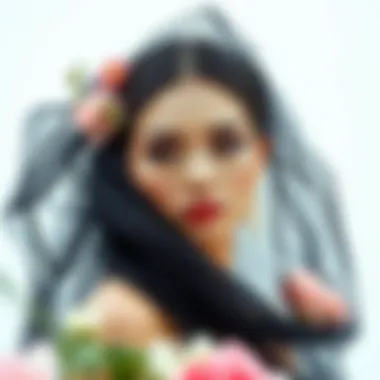
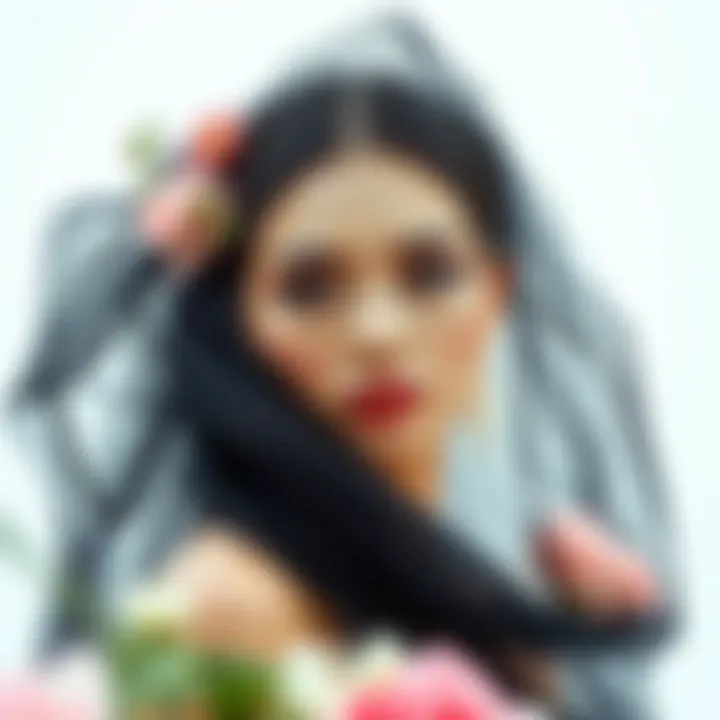
As we delve further into the revival of the black wedding veil in current trends, this historical backdrop provides invaluable insight into the complex interplay between past and present.
The Revival of the Black Wedding Veil
The resurgence of the black wedding veil marks a departure from the traditional confines of bridal fashion. It symbolizes a fresh wave of nonconformity and bold choices that resonate deeply with modern couples seeking to express their individuality. Many brides are now considering this unconventional option as a statement of personal style, moving away from established norms and embracing the idea that weddings can be tailored to fit their unique narratives. As a result, the black veil has reentered the spotlight, embracing its historical relevance while aligning with contemporary values of self-expression and diversity.
Modern Trends in Bridal Fashion
Today's bridal fashion isn’t solely about white gowns and delicate lace; it's evolved into a canvas for vibrant expression. The rise of the black wedding veil can be linked to several factors in modern trends. Couples are leaning towards personalized and thematic weddings that tell their stories. The black veil fits neatly into this narrative, allowing for bolder themes, from gothic to bohemian aesthetic.
- Integration with Custom Gowns: Designers are crafting gowns that complement dark veils rather than clash with them. This includes rich fabric choices such as velvet or silk that enhance the luxurious feel of a black veil.
- Styling Variations: The types of black veils - whether long, short, lace, or opaque - provide ample scope for varied styles. Pairing these with matching accessories drives a cohesive look and fuels creativity among brides.
Influence of Celebrity Weddings
Celebrity culture holds significant sway over public perceptions of fashion. When high-profile figures choose to wear black wedding veils, it pushes the envelope further, cementing their place within modern bridal trends. One notable instance involved the stars opting for darker palettes as a fashion statement during their weddings. This choice garners extensive media coverage and sets trends that the average couple feels inspired to follow.
For example, when actress A wore a stunning black gown with a matching veil, it sent ripples through the wedding planning industry. Designers scrambled to showcase similar options, anticipating a rush of interest. These moments not only celebrate the boldness of individuals but also provoke discussions about tradition and its limitations.
Social Media and Its Role
In the digital age, platforms like Instagram and Pinterest are vital for shaping and promoting wedding trends. Posts of black wedding veils adorned with stunning floral arrangements or intricate lacework consistently garner attention, proving that aesthetics are paramount in the age of visual storytelling. Brides-to-be are blending ideas, often curating mood boards that favor darker, more luxurious themes inspired by these viral posts.
The interactivity of these platforms allows for immediate feedback and encouragement, making it easier for couples to consider non-traditional elements, including black veils. Hashtags such as #BlackWeddingVeil or #DarkBridalFashion nurture a supportive environment, creating communities of like-minded individuals who share their journeys into nonconventional weddings.
The revival of the black wedding veil is not just a trend but a reflection of broader cultural shifts towards individuality and personal narratives in significant ceremonies. This exploration into modern bridal trends, the influence of celebrities, and the role of social media showcases how the black veil encapsulates the spirit of contemporary celebrations.
Style and Fashion Considerations
The black wedding veil is more than just an accessory; it's a statement of individuality, a nod to rich traditions, and a canvas for personal expression. This section seeks to unravel the intricacies and importance of style and fashion when selecting a black wedding veil. From the myriad of styles available to how you choose to incorporate it into your overall wedding attire, understanding these elements can elevate your bridal look beyond mere convention.
Choosing the Right Black Veil
Selecting a black veil involves more than a simple choice of fabric. It's about finding the perfect balance between style and sentiment. Each veil brings its own flavor, from the delicate lace of a cathedral veil to the sleek satin of a blusher. Consider the length; longer veils can add drama while shorter options may lend an air of modernity.
- Types of Veils: Think about options like lace-trimmed, tulle, or silk, each offering unique qualities.
- Length Matters: For dramatic flair, opt for a fingertip or floor-length veil.
- Material Choices: Choosing lighter fabrics may infuse your look with an ethereal quality, while heavier textiles can add a touch of sophistication.
Remember, your choice of veil should align with your personal style and the overall theme of your wedding. If you fancy a gothic theme, a black lace veil might just fit the bill. Conversely, a modern approach may call for a sleek, minimalist design.
Pairing with Wedding Attire
The way a black veil complements your wedding attire is crucial. It should work seamlessly with your dress, enhancing rather than overshadowing it. Here’s how to achieve that perfect match:
- Dress Style: A vintage lace gown pairs beautifully with a bohemian-style curtain veil. In contrast, a form-fitting modern dress can benefit from a sleek, structured veil.
- Color Coordination: The shade of black in the veil can vary, ranging from velvet black to more muted tones. Incorporating a similar shade into your gown or other accessories can create a cohesive look.
- Silhouettes: Ensure that the veil's silhouette harmonizes with the dress's lines; straight-cut dresses often complement straight-cut veils, while flared gowns might benefit from fuller veils.
Accessorizing the Black Veil
No veil is complete without the right accessories. The beauty of a black wedding veil is in its versatility; it can be paired with a variety of adornments, allowing brides to reflect their unique personalities.
- Hair Pieces: Consider a floral headpiece or some vintage-inspired clips that complement both the veil and your attire. Chains of flowers can add a rustic feel, while metal clips might enhance a more modern look.
- Makeup and Jewelry: Your choice of makeup and jewelry should mirror the overall vibe. Dark lipstick can create contrast against a soft gown, or opt for embellished jewelry to radiate a touch of elegance.
- Footwear Choices: Don’t forget about the importance of shoes. Whether you’re going for classic black stilettos or ornate lace-up boots, your footwear should complete the ensemble in synergy with the veil.
"The veil is not just an accessory; it’s an integral part of the bridal story. Choosing it wisely can make all the difference in how you feel on such an important day."
Cultural Considerations and Significance
Understanding the cultural dimensions surrounding the black wedding veil enriches our narrative on this intriguing bridal accessory. For many, a wedding symbolizes more than just the union of two individuals; it reflects a tapestry woven with threads of heritage, beliefs, and practices specific to each culture. The black wedding veil's multifaceted history presents a compelling case, revealing how varying societies interpret and integrate this striking piece into their matrimonial customs.
Black Veils in Different Cultures
Western Perspectives
The Western view of black wedding veils may seem stark or even controversial at first glance. Traditionally, white veils symbolize purity and innocence in Western wedding customs, associated with the bride's virginity. However, the introduction of black veils signals a paradigm shift.
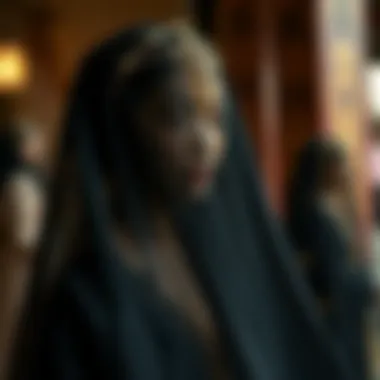
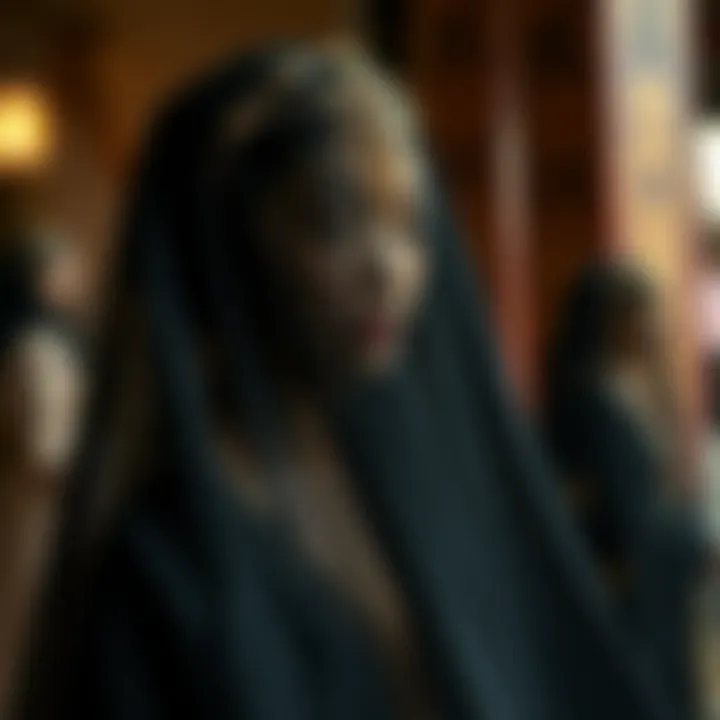
A growing trend sees brides opting for black to embody elegance and sophistication. This choice signifies strength and independence, presenting a bold statement against conventional bridal norms. In this context, the black veil becomes a distinctive alternative, allowing the bride to showcase individuality during the ceremony.
One unique feature of this perspective involves the historical connotation associated with black attire: mourning. Yet, the modern interpretation strips away the negative association, reframing it as a celebration of a new beginning. As such, the Western perspective on black wedding veils has evolved to embrace both personal expression and cultural liberation.
Asian Traditions
In various Asian cultures, colors carry significant meanings, often steeped in millennia of tradition. While white may signify mourning in some Eastern countries, black finds its place more flexibly across different cultures. In certain regions, black is appreciated for its elegance and is worn unashamedly at weddings.
In particular, countries such as India and Japan have celebrated black in wedding attire, albeit in nuanced ways. For example, traditional Japanese kimonos may feature black silk adorned with vibrant patterns, effectively combining the elegance of black with cultural motifs. This blend further emphasizes that black, beyond its surface symbolism, can signify prosperity and strength.
Brides opting for black veils in Asia promote a fresh perspective, showcasing boldness and rebellion against oppressive norms.
African Cultural Practices
Across the African continent, the use of black in wedding ceremonies varies widely, with rich, diverse practices. In some cultures, wearing black or dark hues symbolizes maturity, wisdom, and the solemnity of the vows about to be taken. For instance, among certain Ethiopian ethnic groups, brides may use black veils to complement ceremonial attire, which often integrates intricate beadwork and traditional garments.
The key characteristic that sets this practice apart is its grounding in community and heritage. Here, the black veil represents the importance of family and cultural roots, intertwined with personal accomplishment. This approach provides a unique narrative about weddings within African cultures, where the veil may also represent a bridging between generations.
Latin American Influences
In Latin America, the black wedding veil carries a variety of meanings, shaped by the region’s rich cultural mosaic. In some communities, particularly where folklore still permeates customs, black attire during weddings may pay homage to historical practices surrounding matrimony.
Typical characteristics include the introduction of vibrant colors to complement black veils. For instance, brides may wear black veils adorned with bright flowers or intricate embroidery, resulting in a visually striking balance. This interplay of colors not only elevates the aesthetic but also incorporates local symbolism of joy and life.
Black in this context is not merely a color of mourning. Instead, it celebrates the journey of love, acknowledging trials faced while paving a path toward union.
Religious Perspectives on Black Veils
The exploration of black wedding veils wouldn't be complete without discussing religious interpretations. Different faiths impart unique significances to the color black and its association with wedding attire. In some instances, black suggests humility and obedience, while in others, it symbolizes protection or the spiritual strength of the couple.
Brides from varying backgrounds may choose a black veil not just for aesthetics but also for personal faith beliefs, merging tradition with personal identity. This nuanced understanding broadens our appreciation for the black wedding veil and its varied implications across cultures and religions.
"The journey of the black wedding veil reflects an intricate blend of personal choice and cultural identity, affirming that what lies underneath matters as much as what is outwardly displayed."
In summary, the cultural considerations surrounding the black wedding veil provide a rich entry point into understanding its importance in modern weddings. From Western perspectives shifting to celebrate individuality, to deeply embedded Asian, African, and Latin traditions, the black veil stands as a testament to the evolving nature of bridal fashion.
Black Wedding Veils in Literature and Media
The exploration of black wedding veils in literature and media is a critical avenue that sheds light upon the intertwined fabric of cultural narratives and the evolution of bridal symbolism. These artistic outlets often go beyond mere visuals, revealing layers of meaning that resonate with societal attitudes toward marriage, love, and rebellion. Understanding how black wedding veils manifest in stories—whether in books or in film—allows us to appreciate their growing significance in contemporary bridal fashion.
Representation in Literature
In literature, the use of a black wedding veil often signifies not only the aesthetic choice of the bridal character but also the deeper implications tied to identity and rebellion. Take, for instance, the work of authors who use color as a metaphor to drive their narratives. The black wedding veil can symbolize defiance against traditional norms, as seen in various novels. In many instances, the protagonist who chooses a black veil diverges from the expected path of marital bliss; she questions societal impositions or signifies a darker emotional state.
Such representations are plethora. They challenge readers to reconsider their views on conformity in weddings. Books such as The Girl with the Dragon Tattoo reveal how a character’s choice of attire, including a black veil, may not just be a fashion statement but also a badge of complex inner conflict and personality.
Moreover, the portrayal of black in literary works often alludes to themes of loss, mourning, or even empowerment. When characters don a black veil, it can evoke connections to past traumas or signify a break from conventions, thereby inviting readers to ask, "What does this choice truly imply?" The literary depiction of black wedding veils urges us to examine our own interpretations of weddings and their emotional undercurrents.
Films and Television Interpretations
In the realm of film and television, black wedding veils take on exciting dimensions, serving as visual storytellers. They can blend seamlessly into the aesthetic of a production while enhancing character development and narrative arcs. A gripping example is the film Kill Bill, where the black wedding veil encapsulates the themes of vengeance and loss. It is not merely an accessory but an emblem of what’s been sacrificed and the journey ahead.
Also, various television dramas incorporate black veils to signify dark themes or complex relationships. Noteworthy is when a character in a show opts for a black veil amidst traditional settings. This choice can cause ripples throughout the plot, driving tension or highlighting the stark contrast between characters' desires and societal expectations.
Furthermore, in some contemporary fantasy series, the black wedding veil conjures notions of magic and allure, further entrenching its appeal within various motifs—tradition versus modernity, love versus vengeance. It gets audiences pondering how these facets play out in their own lives and relationships.
In summary, both literature and media provide compelling narratives surrounding black wedding veils, enriching our understanding of their symbolism. Books and films currently resonate with notions of empowerment, rebellion, and self-expression.
"The black veil is an invitation to explore the deeper stories that shape our views on love and marriage."
As we move deeper into these representations, it becomes essential to consider how they inform the choices of modern brides, illuminating paths that transcend the traditional white gown.
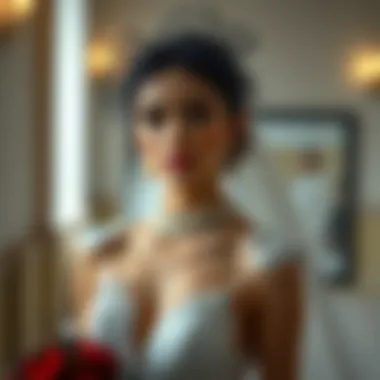

Emotional and Psychological Aspects
The decision to wear a black wedding veil goes beyond mere aesthetics; it intertwines deep emotional and psychological factors. For many brides, the color black has a myriad of meanings, often steeped in personal history and cultural contexts. Assessing these aspects helps illuminate why more brides are gravitating toward this unconventional choice, allowing their wedding attire to become a deeply personal statement.
The Psychology of Color in Weddings
Color plays a substantial role in how we perceive and express emotions. In the realm of weddings, traditionally, white has been seen as the symbol of purity and innocence, but black introduces a different emotional palette. Black often conveys sophistication, power, and a sense of rebellion against convention. It can evoke feelings of mystery but also confidence.
"Color is the keyboard, the eyes are the harmonies, the soul is the piano with many strings." — Wassily Kandinsky.
When a bride opts for a black veil, she's not necessarily renouncing love's purity; rather, she's embracing a more multifaceted narrative. The psychological implications are profound:
- Individuality: A black veil can signify a commitment to self-expression, showcasing a bride's unique personality.
- Strength: This choice can reflect inner strength and a refusal to conform to societal expectations.
- Transitions: Black signifies transformation, serving as a reminder that weddings often usher in new, sometimes uncertain, beginnings.
As the bridal market evolves, understanding how a color choice impacts a bride's emotional landscape encourages designers and stylists to embrace diversity in their creations—catering to those seeking to express their individuality through color.
Personal Significance Behind Choosing Black
Choosing a black wedding veil can be highly personal, speaking volumes about a bride's identity and personal experiences. The meanings behind this choice can vary dramatically from one individual to another. Some may find it an homage to personal loss or as a symbol of resilience. Others might consider it a reflection of cultural heritage, linking back to traditions where black embodies elegance.
- Cultural Ties: In certain cultures, black is regarded as a color symbolizing prestige and celebration, making it a perfect choice for special occasions.
- Emotional Connections: For brides with a rich tapestry of life experiences, the color black can represent depth, maturity, and a journey through darkness into light.
- Rejection of Norms: Some brides embrace the black veil as an act of defiance, turning away from the expectations of the "traditional" wedding.
Practical Tips for Integration
Integrating a black wedding veil into one’s nuptial attire can feel like a daring endeavor. However, approaching this unique accessory with thoughtful planning and a clear vision not only enhances the overall bridal aesthetic but also creates a memorable statement on a wedding day. Understanding the importance of practical tips in this context is pivotal, especially for designers, stylists, and fashion students looking to infuse their creativity into modern weddings.
Planning a Black-Themed Wedding
When one considers a black-themed wedding, it’s essential to create a cohesive aesthetic that embraces the depth and elegance of the color. A black wedding veil serves as a striking centerpiece, but it must harmonize with other elements of the celebration. Here are key considerations:
- Color Palette: Choose complementary colors that enhance black—whites, grays, rich jewel tones or metallics often work beautifully. This creates a balanced yet striking visual that captures attention without overwhelming.
- Venue Selection: Opt for locations that resonate with the chosen theme. A garden under the moonlight, an elegant ballroom, or even a chic loft can provide the perfect backdrop for a black wedding theme. The venue should reflect the mood you wish to establish.
- Floral Arrangements: Incorporate blooms that either feature dark tones or rich contrasts. Think black calla lilies, deep red roses, or even white orchids. Such choices provide both softness and drama, working well with the black veil to enhance the overall look.
- Lighting Considerations: Since black absorbs light, ensuring adequate illumination is crucial. Use creative lighting designs—candles, fairy lights, or uplighting can add warmth and sophistication, making the black elements pop.
- Attire Coordination: The bride’s outfit should blend seamlessly with the veil, whether she opts for a classic white gown paired with a black veil or a fully black ensemble. Encourage exploring various styles that keep the outfit feeling fresh and individual.
As you plan, remember it’s all about how these elements work together to resonate with the vision for the day.
Where to Buy or Custom-Make a Black Veil
Finding the perfect black veil can involve a treasure hunt. Here are some practical avenues to explore:
- Specialty Bridal Stores: Many high-end bridal stores have embraced the trend for black veils. Stores like BHLDN or David's Bridal often carry a range of styles. Visiting them can offer you a hands-on approach to see fabrics and try on different looks.
- Custom Designers: If your vision is distinct, consider working with an independent designer or seamstress. Websites like Etsy feature talented artisans who specialize in custom veils. You’ll have the opportunity to choose the exact materials, styles, and details, offering a personal touch.
- Online Retailers: Platforms such as Amazon or Zola may have a wide array of options from affordable to high-end. It's essential to read reviews and check measurements carefully before purchase, as veil styles can vary significantly.
- Social Media Marketplaces: Instagram or Facebook groups dedicated to bridal fashion can be great for discovering unique finds. Engaging with your community might even lead to second-hand options or customizations others are selling.
- DIY Approach: For the creatively inclined, making your own veil can be both fulfilling and unique. Consider buying tulle or lace from fabric stores, and follow online tutorials to create something that’s truly one-of-a-kind.
By exploring these options, couples can find a black veil that not only accentuates their personal style but enhances the overall wedding theme, making it a memorable day for all the right reasons.
"Black is not just a color, it’s a statement—let that statement echo on your wedding day."
In summary, whether you’re planning or looking for the perfect veil, thoughtful integration will transform your day into an unforgettable celebration.
Culmination
The conclusion serves as a pivotal lens through which we can reflect on the journey the black wedding veil has undertaken in the intricate tapestry of bridal fashion. This accessory, once shrouded in layers of controversy and cultural implications, now represents a nuanced blend of tradition and modern symbolism. By re-examining the elements that contribute to its allure, we can better appreciate not just its aesthetic value, but also its emotional and psychological significance in contemporary weddings.
Summarizing the Black Wedding Veil's Journey
The trajectory of the black wedding veil can be likened to a well-crafted narrative, weaving through history and social norms. Initially steeped in mystique, this adornment drew both admiration and resistance. One can consider the initial association with mourning, yet in recent decades, it has shed that skin, evolving into a bold statement of individuality and defiance against convention. This transition reflects broader social changes, especially as brides increasingly seek to express their personalities rather than adhere strictly to traditional norms.
Notably, the black wedding veil has transcended simple fashion choices. It embodies empowerment and a celebration of diversity in bridal aesthetics. An interesting observation arises when discussing its re-emergence among modern brides. The revival of black veils, often complemented with non-traditional attire, signifies a shift in the collective mindset toward wedding styles, allowing for personal narratives to shine through. Its popularity can also be attributed to a desire to stand out, challenging established norms that dictate what a wedding should look like. Here’s how that journey can be summarized:
- Historical Significance: Once associated with funerals and mourning, black veils brought forth a new wave of considerations about cultural meaning.
- Modern Revival: The influence from celebrities and social media has played a major role in propelling the black veil into the limelight.
- Cultural Acceptance: As societies become more accepting of diverse expressions of love, the black veil continues to find its niche in weddings around the world.
The Future of Wedding Veils in Fashion
Looking ahead, the future of wedding veils—especially black ones—promises to be intriguing. As the fashion industry evolves, so do the trends within it. The black wedding veil is likely to remain a symbol of personal expression, encouraging brides to step out of traditional boundaries. To ensure a strong presence, wedding designers might consider these upcoming trends:
- Integration of Customization: Brides increasingly favor bespoke options tailored to their personalities, potentially leading to more innovative designs in black veils.
- Emphasis on Sustainability: The conscious consumer trend may inspire eco-friendly materials and practices in making black veils, further enhancing their appeal.
- Cross-Cultural Designs: As global influences merge, the marriage of various cultural elements may inspire unique interpretations of the black veil that resonate with a wider audience.
"Fashion is transient, but style is eternal." - Yves Saint Laurent
For further reading on the evolution and significance of wedding veils, consider resources such as Wikipedia and Britannica.







